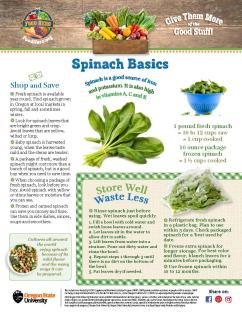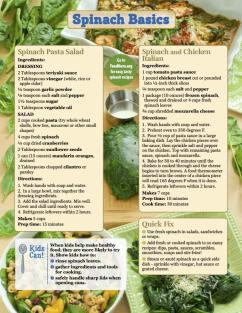Spinach Basics
Spinach is a good source of iron and potassium. It is also high in vitamins A, C, and K
Shop and Save
- Fresh spinach is available year round. Find spinach grown in Oregon at local markets in spring, fall and sometimes winter.
- Look for spinach leaves that are bright green and crisp. Avoid leaves that are yellow, wilted or limp.
- Baby spinach is harvested young, when the leaves taste mild and the stems are tender.
- A package of fresh, washed spinach might cost more than a bunch of spinach, but is a good buy when you need to save time.
- When choosing a package of fresh spinach, look before you buy. Avoid spinach with yellow or slimy leaves or moisture that you can see.
- Frozen and canned spinach can save you money and time. Use them in side dishes, sauces, soups and smoothies.
Store Well Waste Less
- Rinse spinach just before using. Wet leaves spoil quickly.
- Fill a bowl with cold water and swish loose leaves around.
- Let leaves sit in the water to allow dirt to settle.
- Lift leaves from water into a strainer. Pour out dirty water and rinse the bowl.
- Repeat steps 1 through 3 until there is no dirt on the bottom of the bowl.
- Pat leaves dry if needed.
- Refrigerate fresh spinach in a plastic bag. Plan to use within 5 days. Check packaged spinach for a 'best used by' date.
- Freeze extra spinach for longer storage. For best color and flavor, blanch leaves for 2 minutes before packaging.
- Use frozen spinach within 10 to 12 months.
Spinach Basics
Recipes
Spinach Pasta Salad
Spinach and Chicken Italian
Quick Fix
- Use fresh spinach in salads, sandwiches, or wraps.
- Add fresh or cooked spinach to so many recipes: dips, pasta, sauces, scrambles, smoothies, soups, and stir-fries!
- Steam or sauté spinach as a quick side dish - sprinkle with vinegar, hot sauce, or grated cheese.
Kids Can!
When kids help make healthy food, they are more likely to try it. Show kids how to
- rinse spinach leaves.
- gather ingredients and tools for cooking.
- safely handle sharp lids when opening cans.




